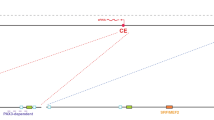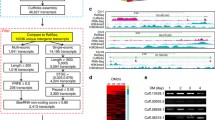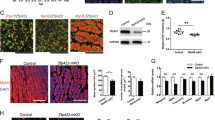Abstract
Myostatin (MSTN) is a strong inhibitor of skeletal muscle growth in human and other vertebrates. Its transcription is controlled by a proximal promoter/enhancer (Mstn P/E) containing a TATA box besides CREB, NF-Y, MEIS1 and FXR transcription factor binding sites (TFBSs), which are conserved throughout evolution. The aim of this work was to investigate the role of these TFBSs on Mstn P/E activity and evaluate the potential of their putative ligands as Mstn trans regulators. Mstn P/E mutant constructs were used to establish the role of conserved TFBSs using dual-luciferase assays. Expression analyses were performed by RT-PCR and in situ hybridization in C2C12 myoblasts and E10.5 mouse embryos, respectively. Our results revealed that CREB, NF-Y and MEIS1 sites are required to balance Mstn P/E activity, keeping Mstn transcription within basal levels during myoblast proliferation. Furthermore, our data showed that NF-Y site is essential, although not sufficient, to mediate Mstn P/E transcriptional activity. In turn, CREB and MEIS1 binding sites seem to depend on the presence of NF-Y site to induce Mstn P/E. FXR appears not to confer any effect on Mstn P/E activity, except in the absence of all other conserved TFBS. Accordingly, expression studies pointed to CREB, NF-Y and MEIS1 but not to FXR factors as possible regulators of Mstn transcription in the myogenic context. Altogether, our findings indicated that CREB, NF-Y and MEIS1 conserved sites are essential to control basal Mstn transcription during early myogenesis, possibly by interacting with these or other related factors.


Similar content being viewed by others
References
Mora A, Sandve GK, Gabrielsen OS, Eskeland R (2015) In the loop: promoter-enhancer interactions and bioinformatics. Brief Bioinform. doi:10.1093/bib/bbv097
McPherron AC, Lawler AM, Lee SJ (1997) Regulation of skeletal muscle mass in mice by a new TGF-beta superfamily member. Nature 387:83–90. doi:10.1038/387083a0
Grobet L, Martin LJ, Poncelet D, Pirottin D, Brouwers B, Riquet J, Schoeberlein A, Dunner S, Menissier F, Massabanda J, Fries R, Hanset R, Georges M (1997) A deletion in the bovine myostatin gene causes the double-muscled phenotype in cattle. Nat Genet 17:71–74. doi:10.1038/ng0997-71
Hu W, Chen S, Zhang R, Lin Y (2013) Single nucleotide polymorphisms in the upstream regulatory region alter the expression of myostatin. In Vitro Cell Dev Biol Anim 49:417–423. doi:10.1007/s11626-013-9621-5
Kambadur R, Sharma M, Smith TP, Bass JJ (1997) Mutations in myostatin (GDF8) in double-muscled Belgian Blue and Piedmontese cattle. Genome Res 7:910–916. doi:10.1101/gr.7.9.910
Reisz-Porszasz S, Bhasin S, Artaza JN, Shen R, Sinha-Hikim I, Hogue A, Fielder TJ, Gonzalez-Cadavid NF (2003) Lower skeletal muscle mass in male transgenic mice with muscle-specific overexpression of myostatin. Am J Physiol. doi: 10.1590/1414-431X20143858
Zimmers TA, Davies MV, Koniaris LG, Haynes P, Esquela AF, Tomkinson KN, McPherron AC, Wolfman NM, Lee SJ (2002) Induction of cachexia in mice by systemically administered myostatin, vol 296. Science, New York, pp 1486–1488. doi:10.1126/science.1069525
Joulia-Ekaza D, Cabello G (2007) The myostatin gene: physiology and pharmacological relevance. Curr Opin Pharmacol 7:310–315. doi: 10.1016/j.coph.2006.11.011
Amthor H, Huang R, McKinnell I, Christ B, Kambadur R, Sharma M, PateL K (2002) The regulation and action of myostatin as a negative regulator of muscle development during avian embryogenesis. Dev Biol 251:241–257. doi:10.1006/dbio.2002.0812
Zhang Y, Li W, Zhu M, Li Y, Xu Z, Zuo B (2016) FHL3 differentially regulates the expression of MyHC isoforms through interactions with MyoD and pCREB. Cell Signal 28:60–73. doi:10.1016/j.cellsig.2015.10.008
Rodgers BD, Garikipati DK (2008) Clinical, agricultural, and evolutionary biology of myostatin: a comparative review. Endocr Rev 29:513–534. doi:10.1210/er.2008-0003
Kubota K, Sato F, Aramaki S, Soh T, Yamauchi N, Hattori M (2007) Ubiquitous expression of myostatin in chicken embryonic tissues: its high expression in testis and ovary. Comp Biochem Physiol A 148:550–555. doi:10.1016/j.cbpa.2007.07.004
George I, Bish LT, Kamalakkannan G, Petrilli CM, Oz MC, Naka Y, Sweeney HL, Maybaum S (2010) Myostatin activation in patients with advanced heart failure and after mechanical unloading. Eur J Heart Fail 12:444–453. doi:10.1093/eurjhf/hfq039
Iwasaki S, Miyake M, Watanabe H, Kitagawa E, Watanabe K, Ohwada S, Kitazawa H, Rose MT, Aso H (2013) Expression of myostatin in neural cells of the olfactory system. Mol Neurobiol 47:1–8. doi:10.1007/s12035-012-8342-1
Li F, Yang H, Duan Y, Yin Y (2011) Myostatin regulates preadipocyte differentiation and lipid metabolism of adipocyte via ERK1/2. Cell Biol Int 35:1141–1146. doi:10.1042/CBI20110112
Manickam R, Pena RN, Whitelaw CB (2008) Mammary gland differentiation inversely correlates with GDF-8 expression. Mol Reprod Dev 75:1783–1788. doi:10.1002/mrd.20918
Sharma M, Kambadur R, Matthews KG, Somers WG, Devlin GP, Conaglen JV, Fowke PJ, Bass JJ (1999) Myostatin, a transforming growth factor-beta superfamily member, is expressed in heart muscle and is upregulated in cardiomyocytes after infarct. J Cell Physiol 180:1–9
Ruan J, Zhang Y, Yuan J, Xin L, Xia J, Liu N, Mu Y, Chen Y, Yang S, Li K (2016) A long-term high-fat, high-sucrose diet in Bamaminipigs promotes lipid deposition and amyotrophy by up-regulating the myostatin pathway. Mol Cell Endocrinol 425:123–132. doi:10.1016/j.mce.2016.02.001
Siriett V, Platt L, Salerno MS, Ling N, Kambadur R, Sharma M (2006) Prolonged absence of myostatin reduces sarcopenia. J Cell Physiol 209:866–873. doi:10.1002/jcp.20778
Hjorth M, Pourteymour S, Görgens SW, Langleite TM, Lee S, Holen T, Gulseth HL, Birkeland KI, Jensen J, Drevon CA, Norheim F (2016) Myostatin in relation to physical activity and dysglycemia and its effect on energy metabolism in human skeletal muscle cells. Acta Physiol 217:45–60. doi:10.1111/apha.12631
Gonzalez-Cadavid NF, Taylor WE, Yarasheski K, Sinha-Hikim I, Ma K, Ezzat S, Shen R, Lalani R, Asa S, Mamita M, Nair G, Arver S, Bhasin S (1998) Organization of the human myostatin gene and expression in healthy men and HIV-infected men with muscle wasting. Proc Natl Acad Sci USA 95:14938–14943. doi:10.1073/pnas.95.25.14938
García PS, Cabbabe A, Kambadur R, Nicholas G, Csete M (2010) Brief-reports: elevated myostatin levels in patients with liver disease: a potential contributor to skeletal muscle wasting. Anesth Analg 111:707–709. doi:10.1213/ANE.0b013e3181eac1c9
Qiu J, Thapaliya S, Runkana A, Yang Y, Tsien C, Mohan ML, Narayanan A, Eghtesad B, Mozdziak PE, McDonald C, Stark GR, Welle S, Naga Prasad SV, Dasarathy S (2013) Hyperammonemia in cirrhosis induces transcriptional regulation of myostatin by an NF-κB-mediated mechanism. Proc Natl Acad Sci USA 110:18162–18167. doi:10.1073/pnas.1317049110
Ju C-R, Chen R-C (2012) Serum myostatin levels and skeletal muscle wasting in chronic obstructive pulmonary disease. Respir Med 106:102–108. doi:10.1016/j.rmed.2011.07.016
Argiles JM, Almendro V, Busquets S, Lopez-Soriano FJ (2004) The pharmacological treatment of cachexia. Curr Drug Targets 5:265–277. doi: 10.2174/1389450043490505
Jespersen J, Kjaer M, Schjerling P (2006) The possible role of myostatin in skeletal muscle atrophy and cachexia. Scand J Med Sci Sports 16:74–82. doi: 10.1111/j.1600-0838.2005.00498.x
Grade CV, Salerno MS, Schubert FR, Dietrich S, Alvares LE (2009) An evolutionarily conserved Myostatin proximal promoter/enhancer confers basal levels of transcription and spatial specificity in vivo. Dev Genes Evol 219:497–508. doi:10.1007/s00427-009-0312-x
Baumann M, Pontiller J, Ernst W (2010) Structure and basal transcription complex of RNA Polymerase II core promoters in the mammalian genome: an overview. Mol Biotechnol 45:241–247. doi:10.1007/s12033-010-9265-6
Yang W, Zhang Y, Li Y, Wu Z, Zhu D (2007) Myostatin induces cyclin D1 degradation to cause cell cycle arrest through a phosphatidylinositol 3-kinase/AKT/GSK-3b pathway and is antagonized by insulin-like growth factor 1. J Biol Chem 282:3799–3808. doi:10.1074/jbc.M610185200
Brindle PK, Montminy MR (1992) The CREB family of transcription activators. Curr Opin Genet Dev 2:199–204. doi: 10.1016/S0959-437X(05)80274-6
Chen AE, Ginty DD, Fan CM (2005) Protein kinase A signalling via CREB controls myogenesis induced by Wnt proteins. Nature 433:317–322. doi: 10.1038/nature03126
Mantovani R (1999) The molecular biology of the CCAAT-binding factor NF-Y. Gene 239:15–27
Zhang X, Odom DT, Koo SH, Conkright MD, Canettieri G, Best J, Chen H, Jenner R, Herbolsheimer E, Jacobsen E, Kadam S, Ecker JR, Emerson B, Hogenesch JB, Unterman T, Young RA, Montminy M (2005) Genome-wide analysis of cAMP-response element binding protein occupancy, phosphorylation, and target gene activation in human tissues. Proc Natl Acad Sci USA 102:4459–4464. doi: 10.1073/pnas.0501076102
Steelman S, Moskow JJ, Muzynski K, North C, Druck T, Montgomery JC, Huebner K, Daar IO, Buchberg AM (1997) Identification of a conserved family of Meisl-related homeobox genes. Genome Res 7:142–156. doi:10.1101/gr.7.2.142
Heidt AB, Rojas A, Harris IS, Black BL (2007) Determinants of myogenic specificity within MyoD are required for noncanonical E box binding. Mol Cell Biol 27:5910–5920. doi:10.1128/MCB.01700-06
Claudel T, Staels B, Kuipers F (2005) The farnesoid X receptor: a molecular link between bile acid and lipid and glucose metabolism. Arterioscler Thromb Vasc Biol 25:2020–2031. doi:10.1161/01.ATV.0000178994.21828.a7
Wilkinson DG (1992) Whole mount in situ hybridization: a practical approach. IRL Press, Oxford, pp 75–83
Rios R, Carneiro I, Arce VM, Devesa J (2001) Myostatin regulates cell survival during C2C12 myogenesis. Biochem Biophys Res Commun 280:561–566. doi:10.1006/bbrc.2000.4159S0006291X00941597
Artaza JN, Bhasin S, Mallidis CON, Taylor W, Ma KUN, Gonzalez-Cadavid NF (2002) Endogenous expression and localization of Myostatin and its relation to Myosin heavy chain distribution in C2C12 skeletal muscle cells. 179:170–179. doi:10.1002/JCP.10044
Budasz-Świderska M, Jank M, Motyl T (2005) Transforming growth factor-β1 upregulates myostatin expression in mouse C2C12 myoblasts. J Physiol Pharmacol 56:195–214
McFarlane C, Vajjala A, Arigela H, Lokireddy S, Ge X, Bonala S, Manickam R, Kambadur R, Sharma M (2014) Negative auto-regulation of myostatin expression is mediated by Smad3 and MicroRNA-27. PLoS ONE 9:e87687. doi:10.1371/journal.pone.0087687
Louis E, Raue U, Yang Y, Jemiolo B, Trappe S (2007) Time course of proteolytic, cytokine, and myostatin gene expression after acute exercise in human skeletal muscle. J Appl Physiol 103:1744–1751. doi:10.1152/japplphysiol.00679.2007
Gurtner A, Fuschi P, Magi F, Colussi C, Gaetano C, Dobbelstein M, Sacchi A, Piaggio G (2008) NF-Y dependent epigenetic modifications discriminate between proliferating and postmitotic tissue. PLoS ONE 3:e2047. doi:10.1371/journal.pone.0002047
Oldfield AJ, Yang P, Conway AE, Cinghu S, Freudenberg JM, Yellaboina S, Jothi R (2014) Histone-fold domain protein NF-Y promotes chromatin accessibility for cell type-specific master transcription factors. Mol Cell 55:708–722. doi:10.1016/j.molcel.2014.07.005
Lee MG, Pedersen PL (2003) Glucose metabolism in cancer: Importance of transcription factor-DNA interactions within a short segment of the proximal region of the type II hexokinase promoter. J Biol Chem 278:41047–41058. doi:10.1074/jbc.M307031200
Osawa H, Robey RB, Printz RL, Granner DK (1996) Identification and characterization of basal and cyclic AMP response elements in the promoter of the rat hexokinase II gene. J Biol Chem 271:17296–17303. doi: 10.1074/jbc.271.29.17296
Magenta A, Cenciarelli C, De Santa F, Fuschi P, Martelli F, Caruso M, Felsani A (2003) MyoD stimulates RB promoter activity via the CREB/p300 nuclear transduction pathway. Mol Cell Biol 23:2893–2906. doi:10.1128/MCB.23.8.2893
Zuloaga R, Fuentes EN, Molina A, Valdés JA (2013) Biochemical and biophysical research communications the cAMP response element binding protein (CREB) is activated by insulin-like growth factor-1 (IGF-1) and regulates myostatin gene expression in skeletal myoblast. Biochem Biophys Res Commun 440:258–264. doi:10.1016/j.bbrc.2013.09.067
Giono LE, Varone CL, Canepa ET (2001) 5-Aminolaevulinate synthase gene promoter contains two cAMP-response element (CRE)-like sites that confer positive and negative responsiveness to CRE-binding protein (CREB). Biochem J 353:307–316. doi: 10.1042/bj3530307
Lamph WW, Dwarki VJ, Ofir R, Montminy M, Verma IM (1990) Negative and positive regulation by transcription factor cAMP response element-binding protein is modulated by phosphorylation. Proc Natl Acad Sci USA 87:4320–4324. doi: 10.1073/pnas.87.11.4320
Ofir R, Dwarki VJ, Rashid D, Verma IM (1991) CREB represses transcription of fos promoter: role of phosphorylation. Gene Expr 1:55–60
Vallejo M, Gosse ME, Beckman W, Habener JF (1995) Impaired cyclic AMP-dependent phosphorylation renders CREB a repressor of C/EBP-induced transcription of the somatostatin gene in an insulinoma cell line. Mol Cell Biol 15:415–424. doi: 10.1128/MCB.15.1.415
Goh S, Looi Y, Shen H, Fang J, Bodner C, Houle M, Ng AC, Screaton RA, Featherstone M (2009) Transcriptional activation by MEIS1A in response to protein kinase A signaling requires the transducers of regulated CREB family of CREB co-activators. J Biol Chem 284:18904–18912. doi: 10.1074/jbc.M109.005090
Salerno MS, Thomas M, Forbes D, Watson T, Kambadur R, Sharma M (2004) Molecular analysis of fiber type-specific expression of murine myostatin promoter. Am J Physiol Cell Physiol 287:C1031–C1040. doi:10.1152/ajpcell.00492.200300492.2003
Cariou B, van Harmelen K, Duran-Sandoval D, van Dijk TH, Grefhorst A, Abdelkarim M, Caron S, Torpier G, Fruchart JC, Gonzalez FJ, Kuipers F, Staels B (2006) The farnesoid X receptor modulates adiposity and peripheral insulin sensitivity in mice. J Biol Chem 281:11039–11049. doi: 10.1074/jbc.M510258200
Rizzo G, Disante M, Mencarelli A, Renga B, Gioiello A, Pellicciari R, Fiorucci S (2006) The farnesoid X receptor promotes adipocyte differentiation and regulates adipose cell function in vivo. Mol Pharmacol 70:1164–1173. doi:10.1124/mol.106.023820.induction
Allen DL, Hittel DS, McPherron AC (2011) Expression and function of myostatin in obesity, diabetes, and exercise adaptation. Med Sci Sports Exerc 43:1828–1835. doi:10.1249/MSS.0b013e3182178bb4
Sundaresan NR, Saxena VK, Singh R, Jain P, Singh KP, Anish D, Singh N, Saxena M, Ahmed KA (2008) Expression profile of myostatin mRNA during the embryonic organogenesis of domestic chicken (Gallus gallus domesticus). Res Vet Sci 85:86–91. doi: 10.1016/j.rvsc.2007.09.014
Buckingham M, Rigby PWJ (2014) Gene regulatory networks and transcriptional mechanisms that control myogenesis. Dev Cell 28:225–238. doi:10.1016/j.devcel.2013.12.020
Kang JH, Noh ES, Park JY, An CM, Choi JH, Kim JK (2015) Rapid origin determination of the Northern Mauxia Shrimp (Acetes chinensis) based on allele specific polymerase chain reaction of partial mitochondrial 16S rRNA gene. Asian-Australas J Anim Sci 28(4):568. doi:10.5713/ajas.14.0613
Acknowledgements
We thank Dr. Mônica Senna Salerno, from AgResearch, New Zealand, for providing the tE4 construct. Special gratitude is due to Dr. Ajeesh Balakrishnan-Renuka, for his help with cell culture, Rana Houmany and Swantje Wulf, for technical assistance at Ruhr-Universität Bochum, Germany.
Funding
This work was supported by National Counsel of Technological and Scientific Development - CNPq [480960/07-0; 142034/2009-6], Fundação de Apoio ao Ensino, à Pesquisa e Extensão - FAEPEX [1039/07], DeutscherAkademischerAustauschdienst - DAAD/CNPq [290068/2010-0], Forschungsförderung Ruhr-Universität Bochum MedizinischenFakultät - FoRUM [6308100907] and Programa Institucional de Bolsas de Iniciação Científica - PIBIC/CNPq [123066/2013-1]. All grant sponsors had no involvement in the conduct of the research and/or preparation of the article.
Author information
Authors and Affiliations
Corresponding author
Ethics declarations
Conflict of interest
The authors declare that they have no conflict of interest.
Electronic supplementary material
Below is the link to the electronic supplementary material.
11033_2017_4126_MOESM1_ESM.tif
Online Resource Fig. 1 Strategy of site-directed mutagenesis used to generate a series of single or multiple mutations in the MstnP/E-Luc construct. Round 1: the four constructs containing single mutated TFBSs were obtained using the wild-type MstnP/E-Luc vector as template; Rounds 2, 3 and 4: multiple binding site mutations were sequentially generated using previously mutated constructs as templates, as schematized above. In our strategy we chose to insert restriction sites (EcoRI, ClaI, PstI, SmaI or NotI, underlined) to disrupt the TFBS (changed nucleotides shown in red) and to facilitate the screening of the clones. All the mutant MstnP/E-Luc constructs were sequenced to confirm the mutagenesis success. The construct obtained in Round 4 with all TFBS disrupted was called ΔMstnP/E-Luc. (TIF 741 KB)
11033_2017_4126_MOESM2_ESM.tif
Online Resource Fig. 2 Analysis of the effects caused by the disruption of TFBS on Mstn P/E activity. After transfection of a series of mutant MstnP/E-Luc constructs into C2C12 mouse myoblasts, effects of single or multiple disruption of TFBS on Mstn P/E were evaluated by changes in luciferase activity in comparison to the wild-type MstnP/E control (black square). Results of upregulation (green up arrows) or downregulation (red down arrows) in P/E activity are shown for each construct. Results were analyzed starting with the construct containing all four TFBS disrupted (ΔMstnP/E-Luc) until getting to the constructs with single TFBS mutated, in order to mimic the effects of the progressive restoration of one, two or three sites to ΔMstnP/E. (TIF 216 KB)
11033_2017_4126_MOESM3_ESM.docx
Online Resource Table 1 Gene specific forward (F) and reverse (R) primers, annealing temperatures and predicted sizes of products generated by RT-PCRs assays for expression analysis in C2C12 cells. The same set of primers was used to generate templates for RNA probes synthesis with the addition of a T7 tail sequence (5´-TAATACGACTCACTATAGGGAGA-3´) to the 5’-end of R primers. Mstn F1 and R1, Myogenin and 16S primers were employed only for RT-PCRs. The second pair of Mstn primers (F2 and R2) was used exclusively to produce templates for RNA probe synthesis. *16Sbr and 16Sar are universal primers that generate a 570 bp PCR product of the 16S rRNA mitochondrial gene used here as endogenous control [60]. (DOCX 23 KB)
11033_2017_4126_MOESM4_ESM.docx
Online Resource Table 2 Primers used for site-directed mutagenesis of the Mstn P/E expression construct. Nucleotides replaced during site-directed mutagenesis are in red; nucleotides substituted in a previous mutagenesis round are shown in blue. For details see Fig.1 of the Online Resource. F: Forward primer; R: Reverse primer. (DOCX 20 KB)
Rights and permissions
About this article
Cite this article
Grade, C.V.C., Mantovani, C.S., Fontoura, M.A. et al. CREB, NF-Y and MEIS1 conserved binding sites are essential to balance Myostatin promoter/enhancer activity during early myogenesis. Mol Biol Rep 44, 419–427 (2017). https://doi.org/10.1007/s11033-017-4126-z
Received:
Accepted:
Published:
Issue Date:
DOI: https://doi.org/10.1007/s11033-017-4126-z




